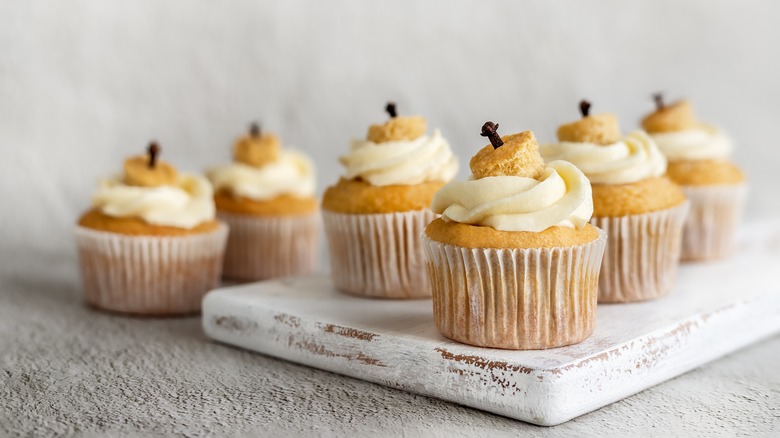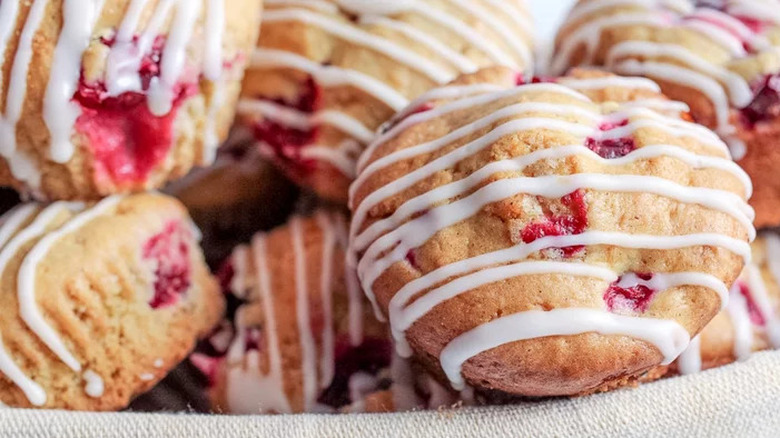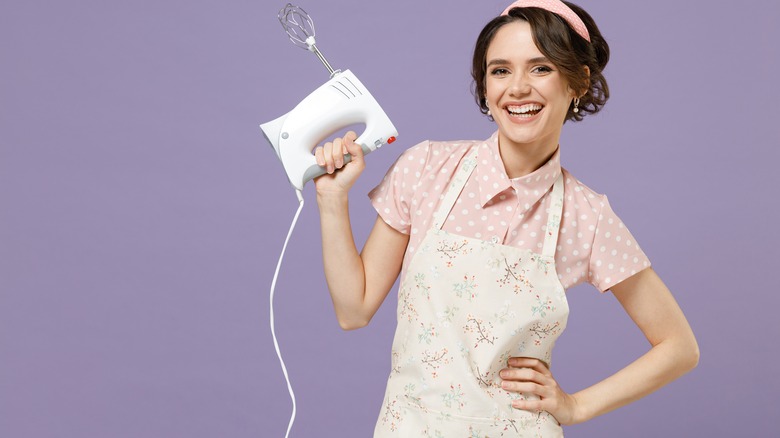Cupcakes Vs. Muffins: Is There Really A Difference?
Cup-shaped, single serving-sized, and baked from a batter made of starch, sugar, fat, and a leavening agent, cupcakes and muffins have so much in common that some would argue the only difference is context — with muffins being for breakfast, and cupcakes being for dessert. That dovetails with the general rule that cupcakes feature frosting while muffins do not.
But that rule has notable exceptions. Consider pumpkin streusel muffins, for example, topped with a sweet and gooey cream cheese glaze. Arguably, that's no less dessert-like than the fluffy cream cheese frosting piled atop pumpkin spice cupcakes.
Others maintain the difference between cupcakes and muffins comes down to the crumb, with cupcakes possessing the more delicate of the two. But how then to account for the sturdy, robust texture of a walnut-studded, frosting-topped carrot cake cupcake? Or the tender cake-like crumb of cranberry orange muffins (which also bear a dessert-like glaze)?
That's why some see the only difference between a cupcake and a muffin as being one of pedigree. To wit, cupcakes derive from cake, while muffins derive from bread – specifically, quick bread. But even that distinction is debatable, per The Nibble, which locates cake and quick bread at points along the same continuum. With so much overlap, can it be said there's any difference between cupcakes and muffins?
A consistent difference between cupcakes and muffins involves their topography
When you look down at the top of virtually any muffin, you'll most likely see a bumpy, ruggedly textured crust that appears almost "cauliflower-like," per the LA Times. And that's a good thing: Many consider the muffin top the best part of the muffin, per Syracuse. Not for nothing, "Seinfeld" devoted an entire episode to the popularity of muffin tops, and in 2018, McDonald's tested out Muffin Toppers on their menu, presumably to appease the many avid fans out there. Even celebrity chef Alton Brown has an easy method for optimizing muffin top size.
By contrast, a bird's eye view of an unfrosted cupcake should look smooth, unbroken, and flat — although not sunken, per YouTube. This may be why cupcakes are associated with frosting — it's as if their bald pates are crying out for adornment; however, most muffins are perfectly suited for going it alone. Moreover, the cupcake's uniform surface makes frosting the cupcake easier and the overall look of the finished product neater.
Given that cupcakes and muffins share the same basic set of ingredients, it would appear the essential difference comes down to technique — as in, what the baker brings to the mix.
Baking techniques and temperatures differ between the two
The first way that the cupcake-making technique differs from muffin-making concerns how the ingredients are mixed, per Pastry Chef Online (PCO). To make muffins, all the dry ingredients are mixed separately from the wet, and then the wet and dry are stirred together either manually or at low speed. The result should be a relatively gloppy, lumpy batter.
Cupcakes start with creaming the butter with the sugar, according to PCO, and end with gradually but vigorously mixing the remaining ingredients in a way that forces air into the batter (via Better Homes & Gardens). The resulting batter should be satiny, smooth, and fluid, per PCO. According to King Arthur Baking, cupcakes are then baked at a low baking temperature, usually between 325 and 375 F, which is true for larger-sized cakes too. The lower baking temperature allows cupcakes to rise slowly and uniformly — encouraging that prized almost-flat cupcake top, as Completely Delicious notes.
Muffins, which don't score points for smooth, flat, frosting-ready tops and for which a crusty and varied topography is ideal, require a higher baking temperature per PCO. This allows the dense muffin batter to bake through internally before the outside has a chance to overbake, the LA Times explains. That said, the LA Times points out that some muffins are meant to be relatively cake-like in nature, so you'll want to bake those at lower cupcake-baking temperatures.


